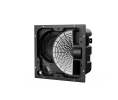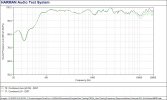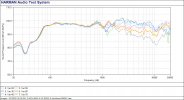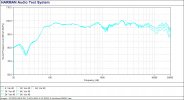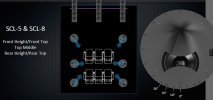I don't like to copy/paste from AVS, but I think it is good to have the info here, in this review thread, but a dealer (Rex from The Screening Room) received a reply from the designer of the speaker. In addition, posted some images. While it wouldbe better of course to have participation here directly, it is still relevant and interesting nonetheless. (
LINK)
"Here is info (and more measurement data) re: ASR's review of the SCL-5 from the engineer who designed it:
We have 6 SCL-5's in the ceiling in a room at Harman, and my opinion is the height information is much better than in the Eargle Theater with SCL-3’s in the ceiling.
It’s really too bad that in our industry, where we design and sell pieces of equipment that are used in a subjective way, that the reviewers of that equipment can’t bother to actually set it up properly and experience it subjectively.
Re: ASR’s review of the SCL-5 and SCL-7, it involves me since I was the engineer on the SCL-5.
I notice we have made only subtle references to how this ceiling speaker should be used in the sales literature. It was designed to sum at 45° to the perpendicular from the mounting plane (ceiling). It was an idea based around making a better ceiling speaker using what we knew about ATMOS ceiling speaker requirements, but was not intended to get Dolby ATMOS certification.
To get a proper summation at 45°, it turns out that the HF compression driver must be inverted in polarity. If I remember correctly, it is actually a quadrature condition, so it could go either way with polarity for the SCL-5. However, when we listened to it in both configurations, we preferred the inverted polarity HF over the positive polarity. When the HF was in positive polarity, the image was right at the ceiling, whereas inverting the polarity resulted in an image down in the room as one would expect – with no change in frequency balance or smoothness of response at 45° off axis.
When you measure this on a 90° axis from the ceiling, you see a cancellation null at crossover. But this measurement doesn’t tell the correct story. You have to measure the SCL-5 (and the SCL-8 for that matter) at 45° off axis toward the woofer side (or more on axis with the horn throat). We note that the coverage angle is +/- 30° off of 45° to the ceiling, so I would think that someone looking to measure the speaker would take the measurement on the 45° axis.
But, I do not want to blame ASR exclusively for this. In our 2 pi chamber, we have a similar issue – the mic array is designed around the 90° axis to the floor (or, speaker’s ceiling mount), so we haven’t been able to generate a full spin yet. We were able to create a proper axial and listening window which I have attached. The axial is an average of our 40° and 50° mics, and the listening window was +/- 10° vertically and +/- 30° horizontally in 10° steps – so, pretty normal.
The great thing about this horn design is its coverage. I am also including an overlay of the vertical off axis curves, from 70° to the ceiling to 20° to the ceiling. You can see that it is pretty reasonable through that angle. You can also see how consistent it is across the range from -30° to +30° horizontally in the other curve.
As to the distortion: we had great concern over it, so we listened with music as well as sine wave at various levels, and discovered
we couldn’t hear it since it was 2nd order. So the decision was made, based on the axial plus listening window measurement attached here, to leave it alone. Moving the crossover higher would damage the sound power response and color the speaker.
Re: the SCL-7 (I have measured it as well and received very similar results): the crossover area is not marked on axis by the dip ASR found. ASR’s nearfield approach likely allows some energy from the driver not being measured into the measurement, and agreed on the distortion comment. I note that for the nearfield measurements, if ASR reviewers can’t shut off the other driver, maybe they could use a Klippel QC station – it has two mics, one for room noise to cancel it out of the measurement, and this could be used to completely remove the other driver from the measurement.
Ultimately, I think we all need to realize that we listen to speakers, so the measurements should be looked at, but at the same time, people need to make the effort to visit The Screening Room or other retailers so they can listen and judge for themselves. They won’t be measuring their speakers every day, but they WILL be listening, so that should be the final arbiter."

